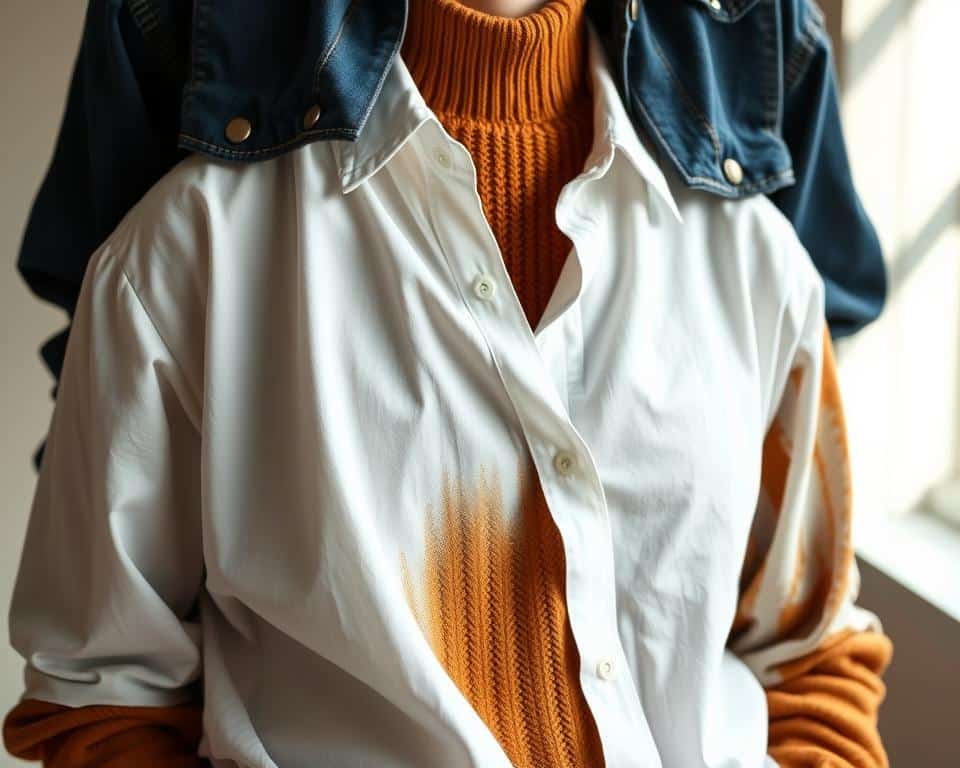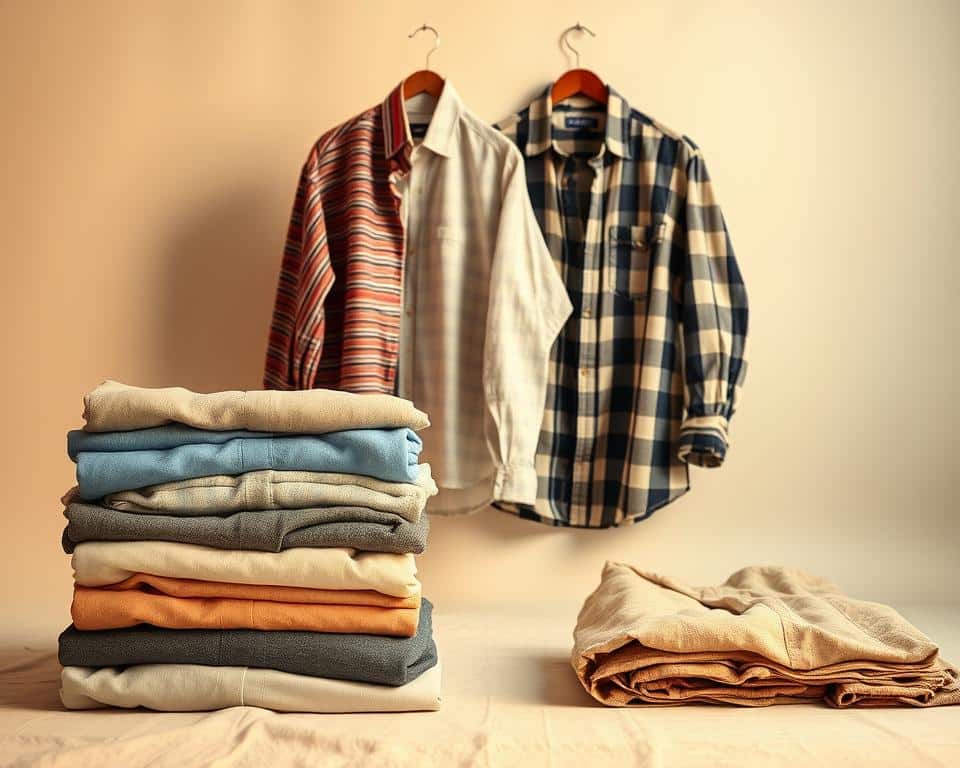How to Layer Casual Wear for All-Season Comfort

Have you ever wondered why your top layer often decides whether your whole outfit succeeds or fails?
This quick guide shows how to build looks that move with your day and the weather. Start with hidden base pieces like undershirts and tees, add a middle layer such as a Henley, sweater, or light blazer, and choose a top layer you can wear all night—think a vegan leather Alphonso jacket over a tank or a lighter Anna jacket over a McKenzie sweater.
Your top layer matters: it should look great on its own and balance stronger patterns with neutral tones. For chilly office AC, an Athens half-zip or an ultra-light Frederick alpaca cardigan adds warmth without bulk.
Follow a simple system from base to outer shell so your outfit stays intentional. Learn quick color and texture moves that upgrade your style now, and check more on how to adapt outfits for the weather in this practical what to wear today piece.
Key Takeaways
- Build outfits from hidden bases to a capable top layer you can wear all night.
- Choose middle layers—sweaters, vests, blazers—for warmth and shape.
- Balance bold patterns with neutrals and keep each piece wearable alone.
- Carry a lightweight weather-proof shell for wind or rain.
- Small adjustments to color and texture deliver a polished look fast.
- For more on practical layer combos, see this focused layering guide.
Why Layering Matters for Everyday Comfort and Style
Smart layering keeps you comfortable from a brisk morning commute to a warm afternoon meeting. It’s about making each part of your clothing pull double duty: warmth when you need it, breathability when you don’t.
Start with a hidden undershirt to protect and smooth. Then let your shirt, a middle piece, and an outer layer work together visually. That mix controls texture and color so your outfit looks intentional all day.
A lightweight shell adds weather-proof protection when rain or wind shows up. Each layer should be strong enough to stand alone so you can shed or add pieces without losing your look.
- Stay comfy through cool mornings and warmer afternoons by adjusting on the move.
- Treat layers as part of your style playbook, not just a cold-weather fix.
- Balance bold colors with neutrals and keep patterns progressive across layers.
For a fun read on pushing your wardrobe limits, check this take on could I be wearing any more.
The Layering System: From Base to Coat
A clear system makes dressing simple: base, shirt, middle, outer, then an optional shell. Follow the order so each piece does one job well. That keeps your look flexible for changing temps and settings.
Base layer
Start with a breathable cotton undershirt or tank that stays hidden. The base should handle sweat and comfort so visible pieces can focus on style.
Shirt layer
Your shirt anchors the outfit — choose a tee, polo, Henley, or button-up that sits clean under other pieces. Make sure shirts are not too long so they tuck or layer smoothly.
Middle layer
This is where shape appears. Pick a sweater, hoodie, vest, or a casual blazer to add structure. A lightweight sweater or a sport coat can give instant definition and options for extra warmth.
Outer layer and shell
Top it with a jacket or coat that fits over everything and covers the silhouette without bunching. On wet or windy days add a thin, weatherproof shell to block the elements.

- Fit matters: outer pieces should close easily over middle layers.
- Reliable pieces: a vegan leather jacket or a light utility jacket can define your look.
- Indoors: reach for a half-zip or an ultra-light alpaca cardigan for easy extra warmth.
casual wear layering tips
Mix textures and proportions to make outfits feel intentional. Small changes—like pairing soft knit with rugged denim—add depth without trying too hard.
Mix textures and fabrics for depth
Pair cotton with denim or wool with leather to create clear contrast. That contrast gives your outfit a richer, more considered look.
Keep neutrals in play, then add one pop of color
Start with a neutral base so the color pops without clashing. One bright piece is all you need to lift the whole outfit.
Play with patterns the smart way
Choose only one statement pattern at a time. Let the rest of the layers support that print so the eye has a clear place to land.
Mind proportions and fit
If your top layer is relaxed, balance it with a slimmer bottom so your body reads clearly. Good fit prevents bulk and keeps things modern.
- Let an underlayer peek at the collar or hem for tidy detail.
- Mix a hoodie under a smart coat or a blazer over a sweater to blend styles.
- Choose pieces that stand alone so you can remove a layer and still look put-together.
| Fabrics | Top Layer | Why it works |
|---|---|---|
| Cotton + Denim | Denim jacket | Casual texture contrast; easy day-to-night outfit. |
| Wool knit + Leather | Leather jacket | Soft vs. smooth contrast adds polish and warmth. |
| Thin tee + Blazer | Unstructured blazer | Smart silhouette without bulk; good for office-to-evening. |
| Hoodie + Coat | Smart overcoat | Street comfort with refined outer shape; versatile look. |
Your Casual Layering Checklist
Build a small closet toolkit so you can assemble a solid outfit fast. Keep the list lean and reliable so you can adapt to temperature changes or a sudden plan after work.
Core tops
- Plain t-shirt, clean long-sleeve shirt, breathable baselayer.
- Quarter-zip and a pullover shirt for quick swaps.
Middle pieces
- Overshirt, a hoodie, a light sweater or cardigan, and a vest that slide over a tee or shirt.
Outerwear
- Zip-jacket, denim or vegan leather jacket, a casual blazer, and a versatile coat.

Bottoms that balance
- Joggers for off-duty looks, cargo or tapered pants for cleaner lines, and black leggings for sleek comfort.
Accessories for warmth and function
- Beanie, scarf, and a sling bag to carry essentials without bulk.
- Keep one cardigan or half-zip at your desk for extra warmth when the AC is high.
| Category | Must-have | Why it helps |
|---|---|---|
| Core tops | Plain tee, long-sleeve, baselayer | Simple foundation that works under every jacket. |
| Middle | Light sweater, hoodie, vest | Adds shape and measured warmth without bulk. |
| Outer | Zip jacket, leather or denim, coat | Protects from wind and completes the outfit for evening. |
Seasonal Layering Formulas You Can Wear Today
A handful of reliable formulas makes dressing for the seasons fast and clear. Use simple combos that balance weight and breathability so you can move through the day without fuss.
Spring swings
Pair a tee with a light sweater and a denim jacket. This layered outfit handles cool mornings and sunny afternoons with ease.
Fall favorites
Try a patterned shirt under a cardigan and add a leather jacket on crisp fall days. The cardigan gives texture while the jacket finishes the outfit.
Winter warmth
Go thermal top plus a chunky sweater, then finish with a coat or weather shell. This formula locks in warmth without losing mobility.
Summer-to-AC
Throw an ultra-light cardigan or half-zip over a tank or tee, then top with a blazer for cold indoor air. Treat your top layer as part of the outfit since you may keep it on.
- Each formula balances weight and air flow so you can adjust during the day.
- Use these as plug-and-play examples to get out the door fast.
- Keep one light layer handy on warm days for night or air-conditioned spaces.
- Rotate textures within each outfit to add interest while keeping colors simple.
| Season | Core formula | Why it works |
|---|---|---|
| Spring | Tee + light sweater + denim jacket | Breathable base, modest warmth, weather-ready outer. |
| Fall | Patterned shirt + cardigan + leather jacket | Texture and warmth for crisp, variable days. |
| Winter | Thermal top + chunky sweater + coat/shell | Layered insulation and weather protection with mobility. |
| Summer-to-AC | Tank/tee + ultra-light cardigan/half-zip + blazer | Cool-day comfort and polished indoor coverage. |
For more seasonal ideas and a wider set of formulas, see these spring style ideas at spring seasonal wear.
Color, Pattern, and Texture Rules That Always Work
When you arrange tones from soft to bold, your outfit reads clean and confident. Follow a few simple rules and each piece will support the whole look.
Go progressive with intensity:
Move light to strong across layers
Start with the lightest pattern or tone at the base and step up intensity as you add layers. This guides the eye and keeps the look considered, not chaotic.
Balance bold shades with grounded neutrals
Use bright color in one or two spots and anchor the rest with neutrals. That gives a pop without overwhelming your style.
Use texture contrast to add depth
Mix wool, cotton, and denim so fabrics give visual interest. Texture makes photos and real life feel richer while each layer still looks great on its own.
- Let a statement pattern lead and keep surrounding pieces simple.
- Check that each layer works solo in case you remove one.
- Add an accent like a hat or scarf only when it supports the story.
| Rule | Why it works | Quick action |
|---|---|---|
| Progressive patterns | Eye moves naturally; outfit feels cohesive | Start subtle, increase intensity outward |
| Bold + neutral | Keeps focus and prevents clash | Limit bold color to one or two spots |
| Texture mix | Adds depth and tactile contrast | Pair wool, cotton, denim for balance |
Use these rules as a simple way to remix your closet. For ideas on core pieces that follow this approach, see these versatile seasonal pieces.
Conclusion
Think of your top piece as the outfit’s final punctuation—it completes and explains the rest.
Build from a clean cotton base and stack each layer so the final look stays sharp all day. Make sure every layer can stand alone. That way you can adapt to weather and time without losing the outfit.
Treat your jacket or coat as part of the outfit since you may keep it on through the night. Balance a bold shirt or sweater with neutral pieces, and move patterns from light to strong as you add layers.
Check fit at every step—how a shirt meets the next layer and how the torso reads with your pants. Over time you’ll collect examples that work: a tee, a light knit, and a leather topper for cool fall days is one simple example that looks great.
FAQ
Q: What’s the basic system for building layers from morning to night?
A: Start with a breathable base like a cotton tee or undershirt, add a shirt or Henley as your anchor, choose a middle layer such as a sweater, hoodie, or lightweight blazer for visible structure, then finish with an outer jacket or coat for protection. Add a shell only if you need wind or rain resistance.
Q: How do I pick fabrics so you don’t overheat or feel clammy?
A: Favor natural or blended fibers up close to your skin: cotton and lightweight merino wick moisture, while wool knits add insulating warmth. Save heavier fabrics like leather or thick denim for outer layers so breathability stays near your torso.
Q: How can you layer without looking bulky?
A: Mind proportions and fit: choose slim, well-cut base pieces, midweight middle layers with some structure, and a slightly roomier outer layer. Keep each layer able to lie flat; avoid two heavy, thick pieces together.
Q: What’s an easy color formula that always works?
A: Keep neutrals as your baseline—navy, gray, beige, black—and add one pop of color in a shirt, sweater, or accessory. This keeps the outfit cohesive while giving it personality.
Q: Can you mix patterns across layers without clashing?
A: Yes. Let one layer carry the statement print and keep the others simple. For example, a patterned shirt under a solid sweater or a checked overshirt under a neutral jacket keeps things balanced.
Q: How do you transition a layered outfit from day to evening?
A: Remove casual outer pieces like a hoodie or overshirt, swap a tee for a crisp button-up or polo, and add a tailored blazer or leather jacket. Small changes—shoes, belt, and a watch—finish the look for night.
Q: Which layers should be visible and which should stay hidden?
A: Base layers are usually hidden; shirts and middle pieces are visible and should anchor the look. Outer layers complete the outfit and protect against weather—let underlayers peek at the hem or collar for visual detail without clutter.
Q: What’s a quick formula for unpredictable spring or fall weather?
A: Tee + light sweater + denim or utility jacket. This combo gives temperature control: shed the jacket when it warms and keep the sweater for cool breezes.
Q: Are there rules for combining casual and smart elements?
A: Blend with intention: pair a hoodie under a smart coat, or a sweater under a blazer. Keep one element noticeably refined so the outfit reads put-together rather than mismatched.
Q: How do accessories fit into a layered outfit?
A: Use accessories for warmth and function—beanie, scarf, and a sling bag. They also give you color and texture options without changing core layers, and they’re easy to remove as temperatures shift.
Q: What outerwear options work best over multiple layers?
A: Look for outer pieces with enough room for a midlayer: trench coats, casual blazers, denim jackets, lightweight parkas, and wool coats. A zip-jacket or vegan leather jacket is also versatile and pairs well with sweaters.
Q: How do you adapt layering for different bottoms?
A: Balance top volume with slimmer bottoms—tapered pants, black leggings, or tailored joggers prevent a bulky silhouette. For relaxed trousers or cargo pants, keep upper layers more fitted to maintain proportion.
